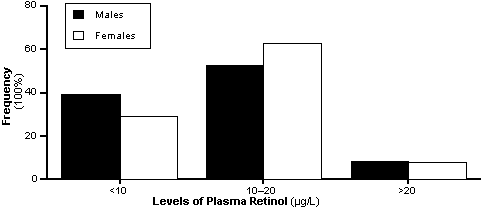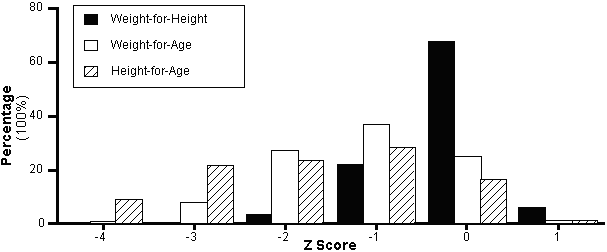| Simon: IVACGP |

|
 | HOUSEHOLD AND MATERNAL DETERMINANTS OF VITAMIN A AND IRON STATUS IN PRESCHOOL CHILDREN IN HAITI WITH SPECIAL ATTENTION TO PARTICIPATION IN WOMEN'S GROUPSJS Chitharanjan, Department of Nutritional Sciences, University of Wisconsin, Madison, USA |
INTRODUCTION:
Evidence for micronutrient deficiency in Haiti has been found in studies which have independently measured anthropometric, dietary or physical characteristics. A comprehensive assessment of nutritional status with attention to vitamin A and iron status was needed. A household survey, physical and ocular exams and blood analysis were completed for a preschool population in the Maissade Commune, Central Plateau Department. This is the first study since 1974 that includes environmental, physical, dietary and biochemical indicators of nutritional status of a preschool population in Haiti. This report focuses on the anthropometric and biochemical status of this population of 2-5 year olds.
OBJECTIVES:
- to determine the extent and severity of vitamin A deficiency in Haitian children, ages 24 to 60 months,
- to examine associations between women's group participation, children's morbidity, and children's nutritional status,
- to determine the extent and severity of iron deficiency in Haitian children, ages 24-60 months.
SUBJECTS AND METHODS:
Sample population: The survey sampling frame consisted of a list of women who participated in women's groups in the 5 zones in the Maissade commune. Women were randomly chosen from this list, sampling proportional to the population in each zone, until 300 households were identified with children between the ages of 24 and 60 months and mother's who participated in a women's group. An additional 300 households were location-matched to these households with the following criteria: a child between the ages of 24 and 60 months, inclusive, and a mother who did not participate in a women's group.
DATA METHODS:
- Women, with children 24-60 months old and who participated in women's groups, were randomly selected from 5 zones in the Maissade commune. These were geographically matched with a woman who had a child 24-60 months old but were not participating in women's groups. N=554 households.
- Children were offered free health examinations. Physical and eye exams were given. Blood was drawn for carotenoid, retinol and iron analyses.
Household Survey. Interviewers administered a household survey collecting information about participation in a women's group, socioeconomic and cultural characteristics, household composition, gardening information, food accessibility information, mother's knowledge of treatment for diseases (respiratory infection, diarrhea, night blindness, goiter, anemia), mother's nutrition knowledge. Information from the target child included immunization history, history of supplementation of vitamin A capsules, recent history of diarrhea, fever or respiratory infection. A 24-hour recall, food frequency and usual eating pattern was collected for the target child. A total of 554 households were surveyed. The mothers were invited to bring their children to the clinic for a free examination.
Clinic examination: Free clinic examinations were offered to all children involved in the study. A complete physical examination including weight, height and upper mid-arm circumference and morbidity history was conducted. An eye examination was performed, with special attention to evidence of conjunctivitis, Bitot's spots, and keratomalacia. 437 children completed the physical and eye examination. 362 children had blood sampled for beta-carotene/retinol analysis. Of these children, 241 children were also sampled for iron analysis. Blood was kept chilled, protected from light and centrifuged within 12 hours. Serum was pipeted into vacutainers and kept refrigerated until transport with blue ice to the USDA laboratory in Beltsville Maryland where it remained frozen until analysis.
Serum analysis: Plasma concentrations of carotenoids and retinol were determined by HPLC at the Carotenoid Research Unit of the U.S. Department of Agriculture (USDA) Phytonutrients Laboratory, Beltsville, MD. Vitamin A status based on the plasma vitamin A concentration was classified according to WHO criteria: <10 ![]() g/dL: severe vitamin A deficiency; 10-19.9
g/dL: severe vitamin A deficiency; 10-19.9 ![]() g/dL: low (marginal vitamin A status); 20-29.9
g/dL: low (marginal vitamin A status); 20-29.9 ![]() g/dL: adequate status; and > 30
g/dL: adequate status; and > 30 ![]() g/dL: normal status. Serum ferritin levels were determined by radioimmunoassay at the USDA Mineral Bioavailability Lab, Boston, MA. Iron deficiency was based on serum ferritin levels <12 ng/mL.
g/dL: normal status. Serum ferritin levels were determined by radioimmunoassay at the USDA Mineral Bioavailability Lab, Boston, MA. Iron deficiency was based on serum ferritin levels <12 ng/mL.
STUDY DESIGN:
Household Surveys, n=554![]()
Clinic examination, n=437![]()
Blood carotenoid/retinol levels, n=362
Serum ferritin levels, n=241
Serum albumin levels, n=203
C-reactive protein levels, n=127
Results are reported for the 229 children who completed the clinic examination and had blood drawn for carotenoid, retinol and iron analysis.
RESULTS:
- 92% of the children were vitamin A deficient or at risk of vitamin A deficiency. 58% had marginal vitamin A status (10-20
 g/dL) and 34% had severely deficient vitamin A status (<10
g/dL) and 34% had severely deficient vitamin A status (<10 g/dL).
g/dL). - Males and females whose mothers did not belong to a women's group have significant differences in plasma retinol levels. (p<0.04)
- Children whose mother's did not belong to a women's group had significantly poorer weight-for-height Z scores than those children whose mothers did belong to a women's group. (p<0.005)
- Twenty percent of children in the study were iron deficient (serum ferritin values less than 12 ng/mL).
The following table shows the characteristics of the sample of preschool children who completed a physical exam, eye exam, and serum blood analysis.
Table 1. Characteristics of study sample (n=229)
| Age of child (mo) | 42.80 ? 10.40* | |
| Gender, % male | 47% | |
| Weight (kg) | 12.67 ? 0.12* | |
| Height (cm) | 89.72 ? 0.47* | |
| MUAC (cm) | 15.03 ? 1.60* | |
| Plasma retinol ( | 12.53 ? 5.03* | |
| Plasma | 7.97 ? 5.04* | |
| Serum ferritin (ng/mL) | 38.80 ? 47.10* | |
| * Mean? SD | ||
The majority of this population (92%) showed less than adequate vitamin A status. 58% had marginal vitamin A status and 34% had severely deficient vitamin A status. The mean plasma vitamin A concentration of all children (n=226) was 12.5 ![]() g/dL. Males had a significantly lower plasma retinol values (11.7
g/dL. Males had a significantly lower plasma retinol values (11.7 ![]() g/dL, SD 4.9) than females (13.2
g/dL, SD 4.9) than females (13.2 ![]() g/dL, SD 4.9) (p<0.02). (See Figure 1.) When the children are divided into two groups based on mother's participation in women's groups, males continued to have significantly lower plasma retinol values compared to females (11.2
g/dL, SD 4.9) (p<0.02). (See Figure 1.) When the children are divided into two groups based on mother's participation in women's groups, males continued to have significantly lower plasma retinol values compared to females (11.2 ![]() g/dL, SD 4.8 vs 13.1 mg/dL, SD 5.06) in the households where women do not belong to a women's group (p<0.04). Serum
g/dL, SD 4.8 vs 13.1 mg/dL, SD 5.06) in the households where women do not belong to a women's group (p<0.04). Serum ![]() -carotene levels were not significantly different between genders.
-carotene levels were not significantly different between genders.
Figure 1. Distribution of Plasma Retinol by Gender (n=226)

Mean serum ferritin levels were 388 ng/mL (SD 47.1). 20% of the population was iron deficient. No correlation was found between plasma retinol levels and serum ferritin levels.
Severe stunting was found in this population (see Figure 2.). 31% were severely stunted as measured by height for age Z sores (HAZ) (9% HAZ of -4 or greater; 22% HAZ of -3). Moderate stunting (-2 Z score) was found in 23% of the population. 36% of the population had weight for age Z scores less than -2. Wasting was found in 4% of the population (-2Z score for weight for height). Children whose mothers did not belong to a women's group had significantly lower (p<0.002) WHZ than those whose mothers participated in women's groups (-0.6, SD 0.9 vs -0.2, SD 1.0).
Figure 2. Height-for-Age, Weight-for-Age, and Weight-for-Height Z Scores

CONCLUSIONS:
- According to international standards, there is a serious public health problem of vitamin A deficiency; warranting serious intervention.
- Anthropometric measures indicate severe growth faltering.
- Children's nutritional status was positively influenced by women's groups.
Vitamin A deficiency is a serious public health concern for Haitian preschool children. Serious growth faltering reflects the poor health status of these children. Further data analysis will indicate the contribution of diet and morbidity to these problems. This study suggests that participation in women's groups has a positive impact on the nutritional status of children. Continued efforts by Save the Children and other organizations, as well as the Ministry of Health, are warranted.
Funded by the Foreign Agricultural Service of USDA, Research and Scientific Exchanges Division and the U.S. Department of State.
November 5, 1999
